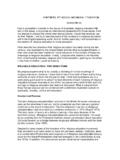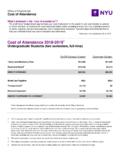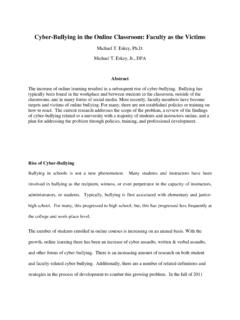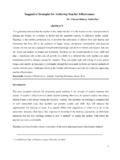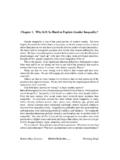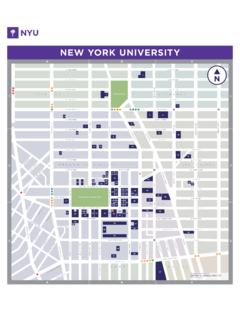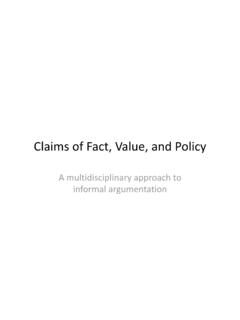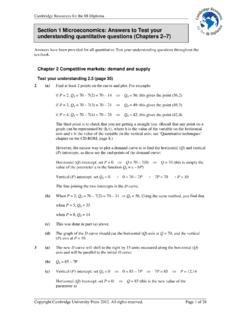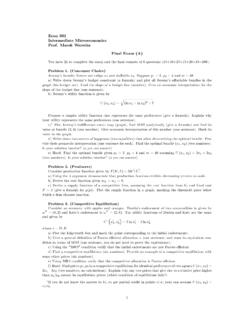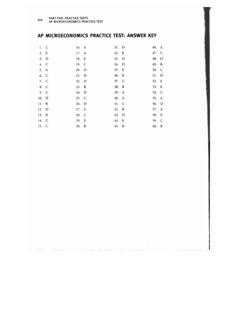Transcription of Intermediate Microeconomics Midterm 2 - nyu.edu
1 Fall 1999 Intermediate Microeconomics Midterm 2 Points 70. Time 70 minutes ( { ). The rst question carries 30 points; the second 40 with parts within them give equal weight to the for Time Allocation: The questions in part (1) should take no more than 5 minutes eachto answer. The questions in part (2) should take you no more than 10 minutes each. This schedulewill allow you to nish the exam in 70 minutes. Good luck.(1)(30 points, 6 points per part) Are the following statements true or false? A simple yes-noanswer willnotsu ce. Explain, with the use of diagrams where necessary.[a]True. A Cobb-Douglas production function is given by the formulaX=AK L ;where and are both positive. If there are increasing returns to one input | say labor | thismeans that > + >1.}
2 It follows that there are increasingreturns to scale. [Extra credit if someone also explains why + >1 means increasing returns toscale.][b]True. If the demand curve is downward sloping, consider the impact of selling one more unit ofthe good. First, one gets the market price evaluated at that quantity | call one more unit is to bring this price down a bit forevery one of the intramarginal revenue. Therefore the gain in revenue | or marginal revenue | is less than the price.[c]True. If we are minimizing costs subject to an output constraint, then the minimum cost pointis given by a tangency of the isocost line with the isoquant. [Draw diagram.] At the tangency, theMRTS equals the factor price ratio.
3 Rewriting this, we see thatMPPLMPPK=wr;which explains the answer. [Extra credit if a student recognizes this but also argues that there maybe corner solutions if both inputs are not used. But this is not needed for full credit.][d]False. This argument neglects free entry. It is possible for individual supply curves to be upwardsloping and for the industry supply curve to be downward sloping. Suppose that an industrial expan-sionlowersthe cost of some input, and that all rms are identical. In that case, industrial expansionwill lower the shut-down price (because inputs are cheaper). Therefore higher industrial output willbe obtained at a lower supply price. At the same time, theindividualsupply curve is upward slopingbecause a competitive rm takes all prices as given and because it has increasing marginal cost curves.
4 [e]False. It depends on the rate of interest because we need to calculate present value, which in thiscase is given by100 +100(1 +i)+100(1 +i)2 This may be smaller than the cost | 280 | if the interest rate is high enough. An example isi=1=5or 20%.(2)(40 points, 10 points per part) Answer the following questions brie y and clearly. You canput in a diagram, and/or a simple example to are not true-false questions.(i)If the (short run) production function is given byX=pL,thentoproduceX, you needX2laborhours. Each labor hour costs 5. So the total cost of labor is given by 5X2. Add to this the xed cost,which is 50, and you getTC = 50 + 5X2:So average total cost is justTC=x,whichisATC =50x+5xAverage variable cost is totalvariable costdivided byx,whichisAVC = 5xTo do the marginal cost calculation, I just require some thoughts, not anything precise.
5 For example,you could add one unit to total cost and observe that total cost rises by the amount5(x+1)2 5x2=10x+5which is not the completely correct answer but will get you full credit. Or you can draw a rm should never shut down in the short run, because for any positive price, it can always nd anXsmall anough so thatp>AVC (see the formula for average variable cost).LK100 Slope = 1 Slope = 2LK100 Isoquants are straightlines with slope = typical cost-minimizingpointThe expansion pathFigure 1:Expansion path for question 2(ii).(ii)Figure 1 shows you the correct diagram. The isocost lines have a slope of 1 until labor hourscross 100, after that, the slope becomes 2 because of the overtime. In the second panel, we draw inthe isoquants which are straight lines with a slope of (the reason is that units ofKmust beadded to compensate for the loss of 1 unit ofL).
6 This means that the solution is at a corner (onlylabor is used in production) unless labor hours cross 100. Thereafter capital is used. The expansionpath is therefore the "inverted L" shown in boldface in the second panel of Figure 1.(iii)Consult Figure 2 in what follows. In the rst panel, we show the competitive equilibrium beforea quota is imposed. At the equilibrium priceP and quantityQ , it is easy to see that total consumersurplusisgivenbytheareaA, while the total producer surplus is given by the areaB. In the secondpanel, the quota is imposed. Now the equilibrium price will have to be the price that clears the2coffee unitscoffee priceQ*coffee unitscoffee priceeq. quantityquotaP*ABnew PCDF igure 2:Diagram for question 2(iii).
7 Market with a quota | it is the demand price at the quota. I have drawn it in as \newP". The newconsumer surplus isCand the new producer surplus isD.(a) It should be absolutely obvious thatC<A(the price has gone up, so consumer surplus musthave fallen). ButDandBarenot, in general, comparable, It is true that there is a quota; this lowersproduction and tends to lower producer surplus. But the price has gone up. SoDmay well be credit will be given if someone argues thatDwill exceedBwhen the demand curve for co eeis follows that consumers will always oppose the quota, while producers may support it (ifD>B).(b) Now notice that whatever the ambiguities betweenBandD,thesumA+Bmust be greaterthan the sumC+D.
8 Therefore a quota must lower theunweightedsum of producer and consumersurplus. It follows that the government, in imposing the quota, cannot be placing equal equal weighton consumer and producer surplus. Indeed, it must be placing a higher weight on producer surplus.(iv)This question is completely standard and its grading will therefore be strict, to make sure thatall the points are properly made. The rst point is the shutdown rule. You should draw the averagevariable cost curve, where the notion of what is \variable" depends on whether we are considering theshort or the long run. Then mark the minimum point of this curve. State that if the price is lowerthan this, the rsm will shut down, and explain second point is the pro t-maximizing rule should the rm decide to produce.
9 Here you shouldstate that price equals marginal cost, and you must explain why. The explanation can be done ina variety of ways. (1) you can argue verbally, saying that if this is not the case, then we have acontradiction by either expanding or contracting output. (2) You can argue graphically, drawing thetotal revenue curve (a straight line) and the total cost curve and arguing that the objective is to makethe vertical distance between these two as large as who argue thatP= MC and the shutdown rule are together necessary but still notsu cient will get some extra credit. This is because the \price equals marginal cost" equality mayhappen at many di erent points, some of which may be local
